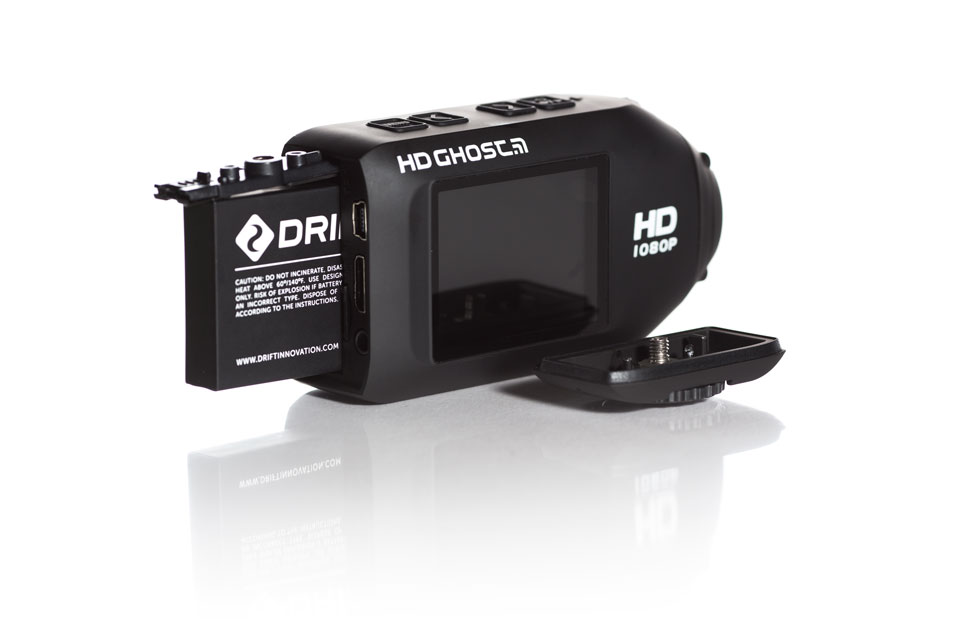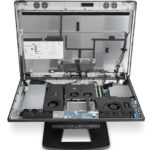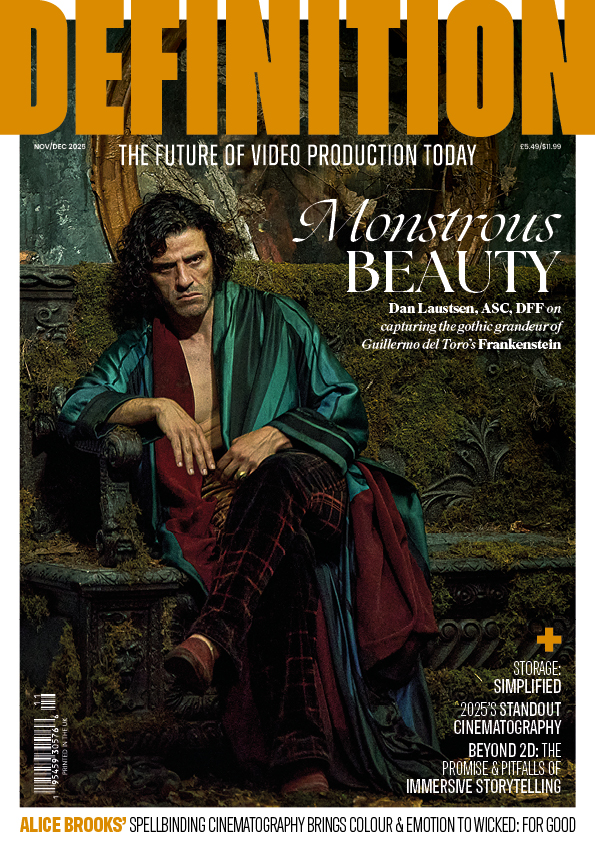
Review: Drift Innovation HD Ghost Action Camera
Posted on Mar 4, 2013 by Alex Fice
The HD Ghost has a screen as standard.
Click on the magazine layout image for a pdf download of the article (2.8Mb)There is a lot to like about Drift Innovation’s HD Ghost. From the moment you open the gorgeous packaging, the camera oozes quality. The body is magnesium alloy finished in the mattest of matte black. The LCD cover is Corning’s Gorilla Glass – the same stuff they make smartphone screens from. There is a good range of accessories supplied and the specification of the basic model is outstanding.
Unlike the boxy GoPro Hero, the HD Ghost is bullet shaped, with the lens on one end. This more aerodynamic shape makes more sense than the GoPro – you can mount it more discreetly on the side of a helmet or vehicle, aided by the fact that the sensor assembly can be rotated through 300º, so you don’t have to mount the camera body level. The only thing the bullet shape prevents is a chest mount – you don’t want to stab the talent in the heart with a camera when they fall on their faces. Well, depends on the talent, I suppose…
The roll call of features really starts with the built-in 2in LCD screen, allowing the HD Ghost to have a simple and intuitive user interface, accurate framing, instant playback – obvious requirements for a video camera, but missing from some of the competition unless you buy optional extras.
Next up is the fabulous little remote control. This light, wearable unit has an even simpler user interface – two large, rubberised buttons, and highly visible, multicolour LEDs running both sides of the case. The remote is in two-way communication with the camera, so you don’t get the record tally lights on until the camera is really in record (nice) and can be charged over USB (the Li-ion battery lasts about eight hours, but can’t be removed). It can control shooting mode (shown by LED colour on both the camera and remote) as well as record/stop, and can put any number of cameras into record simultaneously, from up to 10 meters away.
The standard HD Ghost comes with WiFi built-in, and there is a free app for the iPhone, with Android on the way soon (at the time of writing). The camera feeds live video to your phone, and the app provides full control of the camera, including changing modes and settings, and putting the camera into record. When the camera is recording, you lose the live feed, which is a shame. Unfortunately, the camera crashed a couple of times when recording using the iPhone app – I had to take the battery out to ‘reset’ it, but Drift are pretty good at releasing firmware updates and the updating process is relatively easy. The WiFi link isn’t secure, so anyone can connect to it – I’d hope to see some form of security available in future updates.
Unlike the GoPro, there is no waterproof housing supplied as standard. Partially, that’s because the basic unit is waterproof to a rated depth of three metres (in other words, surface swimming, surfing, being stuck on a motorcycle in the rain etc.). There is a full housing coming soon as an optional extra, rated to a depth of 60 metres.
The HD Ghost has four main modes of operation: video, stills (five, eight or 11 Mpixels), burst (a burst of five or 10 stills for up to five seconds), and timelapse (from 0.5s to 60s per frame). We’ll concentrate on the video capabilities here.
1080p resolution is available at 25 and 30fps. Sensor windowing gives fields of view of 170º, 127º and 90º. There is also a 960p mode (which uses the natural 4:3 ratio of the CMOS sensor), 720p (at 25, 30, 50 and 60fps) and WVGA at up to 120fps.
Exposure is, basically, totally automatic – there is, however, exposure compensation available from the settings menu – and the lens is fixed focus (effective focus from 0.5 metres to ∞. The CODEC is H.264 at about 15Mbits/s, wrapped as an mp4 or mov file, and files are recorded to a (not supplied) micro SD card (minimum of Class 6 and up to 32GB). There are no horrible surprises for post-production here.
The micro SD card, removable battery and USB port are hidden behind a waterproof, screw-down hatch at the rear of the camera, along with a mini HDMI output and 3.5mm jack for an external microphone input (there is an internal mic). There is a second hatch cover supplied with openings for the USB and mic input, though this compromises the waterproofing, of course – it’s dust and splash proof at best. The battery lasted for over 2½ hours of 1080p recording (much, much better than a GoPro) and it recharges whilst USB is connected. There is an optional mains charger available.
Four rubberised buttons on the top of the camera provide everything you need for the user interface. There is an Action button (power on/off, record/stop), two cursor controls (forwards and back) and the Menu button. Pressing the Menu button when the camera is recording (or pressing Action on the remote) will capture a still image, without disturbing the video recording. There is an interesting video mode, called Video Tagging. This mode continuously records video (the loop length is adjustable up to five minutes) – pressing Menu stops the looping, effectively capturing events that happen before you press the button, plus an equal time after the event. So, for instance, if you set up a 30s loop, pressing Menu records the previous 30s, the current 30s and the next 30s – 1m30s in total. So, surf dudes can set the loop running, surf until they catch an awesome tube (er… whatever that means) and trigger the Video Tagging from the remote. The HD Ghost will record the view from the green room, getting drilled (axed or otherwise wiped out), and the noah’s teeth as they chomp through your wettie. Bodacious!
Action cameras aren’t particularly renowned for their image quality, but in good light the HD Ghost performs very well. Colour rendition is good and even the internal mic performs well enough (except for the inevitable wind noise at high speed). There have been various reports of the camera mis-judging exposure, but I wasn’t able to provoke this behaviour with the latest firmware. Lowering the light level demonstrates the problems with a tiny sensor and low bit-rate CODEC – noise and compression artefacts increase dramatically, but that’s a problem with all the action cameras on the market.
The Drift HD Ghost is £299 inc VAT, which is fantastic value for money. The GoPro Hero 3 Black edition is lighter, probably has the edge on picture quality, and will do 60fps at 1080p (nice), but it’s £60 more, plus another £80 if you want to add an LCD screen. Similarly, the GoPro Silver Edition (£280) has an almost identical picture spec to the Drift, but you’ll need to add the screen (£80) and the remote (another £80) for match it for features. Add to the value the HD Ghost’s luscious magnesium case and the rotating lens, and the GoPro range has serious competition.








